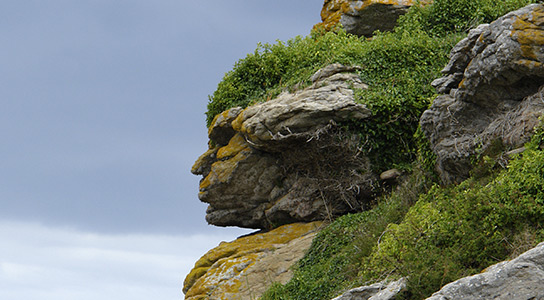
How does the human brain recognize faces and distinguish between genuine faces and objects that resemble faces? A new study by Professor Pawan Sinha at MIT and his colleagues indicates that looked at brain activity indicates that both hemispheres are involved in this decision.
Objects that resemble faces are everywhere. Whether it’s New Hampshire’s erstwhile granite “Old Man of the Mountain,” or Jesus’ face on a tortilla, our brains are adept at locating images that look like faces. However, the normal human brain is almost never fooled into thinking such objects actually are human faces.
“You can tell that it has some ‘faceness’ to it, but on the other hand, you’re not misled into believing that it is a genuine face,” says Pawan Sinha, professor of brain and cognitive sciences at MIT.
A new study from Sinha and his colleagues reveals the brain activity that underlies our ability to make that distinction. On the left side of the brain, the fusiform gyrus — an area long associated with face recognition — carefully calculates how “facelike” an image is. The right fusiform gyrus then appears to use that information to make a quick, categorical decision of whether the object is, indeed, a face.
This distribution of labor is one of the first known examples of the left and right sides of the brain taking on different roles in high-level visual-processing tasks, Sinha says, although hemispheric differences have been seen in other brain functions, most notably language and spatial perception.
Lead author of the paper, published Jan. 4 in the Proceedings of the Royal Society B, is Ming Meng, a former postdoc in Sinha’s lab and now an assistant professor at Dartmouth College. Other authors are Tharian Cherian ’09 and Gaurav Singal, who recently earned an MD from the Harvard-MIT Division of Health Sciences and Technology and is now a resident at Massachusetts General Hospital.
Face versus nonface
Many earlier studies have shown that neurons in the fusiform gyrus, located on the brain’s underside, respond preferentially to faces. Sinha and his students set out to investigate how that brain region decides what is and is not a face, particularly in cases where an object greatly resembles a face.
To help them do that, the researchers created a continuum of images ranging from those that look nothing like faces to genuine faces. They found images that very closely resemble faces by examining photographs that machine vision systems had falsely tagged as faces. Human observers then rated how facelike each of the images were by doing a series of one-to-one comparisons; the results of those comparisons allowed the researchers to rank the images by how much they resembled a face.
The research team then used functional magnetic resonance imaging (fMRI) to scan the brains of research subjects as they categorized the images. Unexpectedly, the scientists found different activity patterns on each side of the brain: On the right side, activation patterns within the fusiform gyrus remained quite consistent for all genuine face images, but changed dramatically for all nonface images, no matter how much they resembled a face. This suggests that the right side of the brain is involved in making the categorical declaration of whether an image is a face or not.
Meanwhile, in the analogous region on the left side of the brain, activity patterns changed gradually as images became more facelike, and there was no clear divide between faces and nonfaces. From this, the researchers concluded that the left side of the brain is ranking images on a scale of how facelike they are, but not assigning them to one category or another.
“From the computational perspective, one speculation one can make is that the left does the initial heavy lifting,” Sinha says. “It tries to determine how facelike is a pattern, without making the final decision on whether I’m going to call it a face.”
Key to the research was imaging-analysis technology that allowed the scientists to look at patterns of activity across the fusiform gyrus.
“This is a relatively recent innovation — looking at the pattern of activation as opposed to overall activation,” says Thomas Busey, associate professor of psychological and brain sciences at Indiana University, who was not involved in this research. “Anytime you have a measure that replicates and correlates with human behavior, that seems to be a pretty compelling story.”
Timing is instructive
The researchers found that activation in the left side of the fusiform gyrus preceded that of the right side by a couple of seconds, supporting the hypothesis that the left side does its job first and then passes information on to the right side.
Sinha says that given the sluggishness of fMRI signals (which rely on blood-flow changes), the timing does not yet constitute definitive evidence, “but it’s a very interesting possibility because it begins to tease apart this monolithic notion of face processing. It’s now beginning to get at what the constituents are of that overall face-processing system.”
The researchers hope to obtain more solid evidence of temporal relationships between the two hemispheres with studies using electroencephalography (EEG) or magnetoencephalography (MEG), two technologies that offer a much more precise view of the timing of brain activity. They also hope to discover how and when the right and left sides of the fusiform gyrus develop these independent functions by studying blind children who have their sight restored at a young age. Many such children have been treated by Project Prakash, an effort initiated by Sinha to find and treat blind children in India.